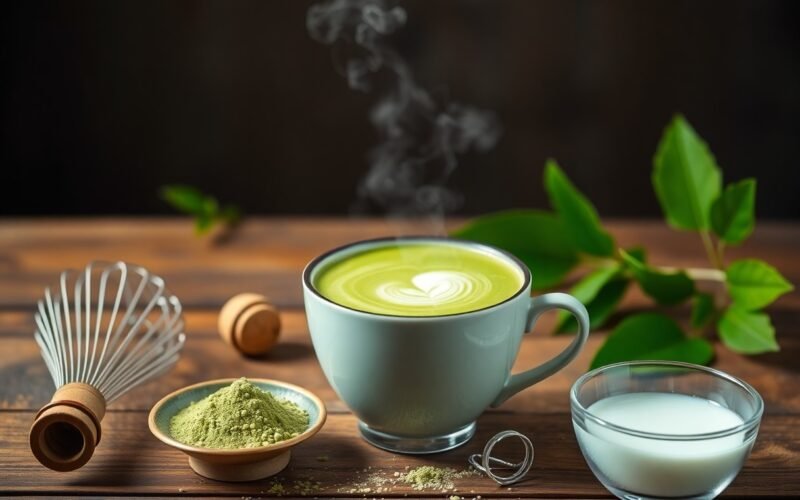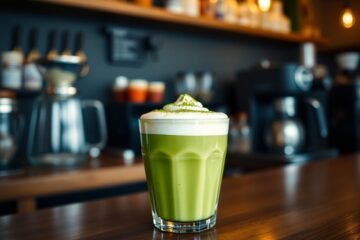Matcha has taken the wellness world by storm, and brewing it into a delicious latte at home is easier than you might think. You’ll be surprised by how simple it is to create your own creamy, vibrant matcha latte in just a few steps. With the right tools and technique, you can enjoy this health-boosting beverage that not only delights your taste buds but also energizes your day. Let’s get started on your journey to brewing the perfect matcha latte that you can be proud to share!
Key Takeaways:
- Choose high-quality matcha powder for a vibrant color and rich flavor in your latte.
- Use a whisk or frother to properly mix the matcha with hot water, ensuring a smooth and lump-free consistency.
- Experiment with different milk options and sweeteners to customize your matcha latte to your taste preference.
The Quest for Quality: Selecting Exceptional Matcha
Quality is key when it comes to crafting the perfect matcha latte. The flavor, color, and nutritional benefits all hinge on choosing a premium matcha. Look for bright green, vibrant powder that indicates high chlorophyll content, which comes from shade-grown tea plants. A great matcha not only enhances your latte but also enriches your overall experience, allowing you to enjoy the nuanced taste and health benefits of this ancient beverage.
Understanding Matcha Grades: Ceremonial vs. Cooking
Matcha comes in various grades, with ceremonial grade being the highest. This premium matcha is best for traditional tea preparation and lattes, offering a delicate, smooth flavor profile. On the other hand, cooking grade matcha, while still useful, is more robust and slightly bitter, making it ideal for recipes where other ingredients can balance the taste.
Identifying Authenticity: Tips for Sourcing High-Quality Matcha
To guarantee you’re purchasing authentic, high-quality matcha, consider these tips: always choose matcha from cultivated regions, like Uji, Nishio, or Shizuoka in Japan. Look for brands that provide clear labeling with information about origin, and avoid any that use fillers or additives. Opt for matcha packed in opaque or UV-protected containers to maintain freshness. Any choice you make can impact your latte experience, so prioritize authenticity.
- Choose matcha sourced from Japan’s top regions.
- Look for clear labels detailing origin.
- Avoid brands with fillers or additives.
- Opt for opaque packaging to enhance freshness.
- Any move you make towards quality will reflect in your matcha latte.
Further exploring authenticity can enhance your matcha journey. Researching brands and their production methods will help you identify reputable sources. Engage with the matcha community through forums or dedicated social media groups, as this can lead to recommendations of trusted suppliers. Many high-quality matcha suppliers also offer tasting packs for you to experience different flavors and grades before committing to a larger purchase. Any extra effort you put into sourcing will elevate your matcha lattes to an exceptional level.
- Research brands for their production methods.
- Engage with the matcha community for recommendations.
- Explore tasting packs from suppliers.
- Commit to high-quality sources for better lattes.
- Any investment in quality will not go unnoticed in your brewing experience.
Essential Tools for Matcha Mastery
Brew your perfect matcha latte at home with the right tools that elevate your experience. Start with a high-quality Matcha Latte Recipe for your delicious creation. The right utensils not only simplify the process but also enhance the flavor and presentation of your drink.
Must-Have Utensils: The Whisk, Bowls, and More
To achieve that beautiful, frothy finish, invest in a traditional bamboo whisk, known as a chasen, which effortlessly blends matcha powder into water. Pair this with a wide bowl called a chawan, designed to allow vigorous whisking without spills. Additionally, a sifter can help to avoid clumps, ensuring a smooth consistency, while a thermometer can help you achieve the ideal water temperature.
The Role of Water Temperature: Why It Matters
Water temperature significantly affects the flavor and health benefits of your matcha latte. Ideally, water should be heated to around 160°F to 175°F (70°C to 80°C). Using water that’s too hot can turn your matcha bitter, negating the sweet and umami flavors you want to enjoy. Conversely, water that’s not hot enough may fail to fully dissolve the powder, leading to a gritty texture.
| Temperature Range | Effect on Matcha |
| Below 160°F | Can cause clumping; flavor is poorly extracted |
| 160°F – 175°F | Perfect range for a smooth, vibrant taste |
| Above 175°F | Can create bitterness; masks matcha’s natural sweetness |
Steeping matcha at the right temperature unlocks its full potential. Hotter water can release tannins, leading to unpleasant bitterness. To maintain the delicate balance of flavors, consider pairing your preparation with a thermometer for precision—it’s a small step that yields significant benefits, allowing you to savor the full spectrum of your matcha’s taste.
| Method | Description |
| Thermometer | A kitchen thermometer can precisely gauge temperature |
| Water Kettle | Invest in an electric kettle with temperature settings for convenience |
| Cooling | Let boiling water cool for 5-10 minutes before using |
Perfecting Your Recipe: Steps to Crafting a Delicious Matcha Latte
Creating a delicious matcha latte at home involves a few important steps that can elevate your brew from good to outstanding. Start by selecting your matcha powder and milk wisely; these two ingredients define your drink. Focus on achieving the right balance of flavors and textures. A well-crafted matcha latte harmonizes the earthy notes of matcha with the creaminess of the milk, making every sip a delightful experience. With a few easy steps, you’ll quickly find your personal matcha latte recipe that suits your taste.
The Right Ratios: How Much Matcha and Milk to Use
Perfecting the ratio of matcha to milk is fundamental for achieving a balanced flavor in your latte. Typically, use about 1 to 2 teaspoons of matcha per 8 ounces of milk. Adjust these amounts based on your personal preference and the strength of the matcha you’re using. If you enjoy a more robust flavor, opt for a fuller teaspoon or two, while newcomers might prefer starting with one for a milder taste.
Preparing the Ingredients: Sifting, Mixing, and Frothing Techniques
Preparing your matcha correctly sets the stage for a great latte. Sifting the matcha powder helps avoid clumps, promoting a smooth consistency when mixed. Once sifted, whisk the matcha with a small amount of hot water (not boiling) until it forms a smooth paste. For frothing milk, use a milk frother or steam wand and aerate it until it’s creamy and frothy, ideally achieving a velvety texture perfect for blending with your matcha. A proper flow of technique here elevates your drink significantly.
The technique of preparing your matcha ingredients is fundamental to creating that ideal matcha latte experience. Sifting your matcha through a fine mesh strainer before mixing breaks up any clumps and ensures a more consistent texture in your final drink. Next, when whisking the matcha with a small amount of hot water, use a bamboo whisk (chasen) in a ‘W’ motion to fully incorporate the powder, creating a rich and frothy mixture. Finally, for the milk, whether you choose dairy or a plant-based alternative, ensure it’s heated to around 150°F before frothing. This warm temperature helps meld the flavors while maintaining nutritional integrity. Mastering these preparation techniques will undoubtedly enhance the quality of your matcha lattes at home.
Elevating Your Matcha Game: Customizing Your Latte
Taking your matcha latte to the next level is all about customization. You can explore various flavors, sweeteners, and even presentation styles to create a drink that excites your palate. For inspiration on how to alter your iced matcha latte, check out discussions in the community, such as How do you guys make your iced matcha latte? This exploration opens a world of possibilities that can enhance your daily ritual.
Flavor Enhancements: Sweeteners, Spices, and More
Sweeteners like honey, agave syrup, or maple syrup can make your matcha latte irresistibly delicious. You might also try sprinkles of cinnamon or nutmeg for a cozy twist. A dash of vanilla extract can enhance the overall flavor, while cayenne pepper can add a surprising kick. Experimenting with natural flavorings allows you to create a latte perfectly suited to your taste and mood.
Alternative Milks: Which Ones Work Best for a Creamy Finish
Choosing the right milk is necessary for achieving that creamy texture in your matcha latte. Almond, oat, coconut, and soy milks all provide unique flavors and consistencies. Oat milk, for instance, is celebrated for its thick creaminess that complements the earthy matcha, while coconut milk offers a tropical twist. If you’re looking for dairy-free options that mimic the richness of whole milk, many baristas swear by barista blends designed specifically for coffee and tea drinks.
Oat milk stands out as a popular choice among matcha enthusiasts. Its naturally sweet profile and rich consistency create a harmonious blend with matcha, enhancing both flavor and texture. Additionally, the way oat milk froths makes it ideal for lattes, achieving that perfect foam layer on top. Unsweetened almond milk is another choice, offering a lighter feel with a nutty undertone that can also complement the grassiness of matcha. Ultimately, your preference will guide your choice—experimenting with various brands can lead you to discover the perfect alternative milk for your ideal creamy matcha latte.
Troubleshooting Common Mistakes: Achieving Matcha Excellence
Crafting the perfect matcha latte can sometimes encounter hiccups, but recognizing common mistakes can help you fine-tune your technique. Consistency and technique are vital in achieving that creamy, frothy finish you crave. Whether it’s grainy texture or bitterness, understanding these common pitfalls will set you on the path to matcha excellence every time.
Avoiding Grainy Lattes: Tips for Smoothness
Grainy matcha lattes can be a disappointment, but there are several tips to enjoy a smooth experience. Aim for high-quality matcha, and always sift your powder before mixing to reduce clumps. Use a whisking motion to effectively dissolve the matcha, and incorporate your liquid gradually to ensure it blends seamlessly. Consider using a milk frother for an extra creamy texture that helps eliminate graininess.
- Sift your matcha to break up clumps
- Gradually add liquid when mixing
- Utilize a whisk or milk frother for best results
- Always choose quality matcha powder
Recognizing these details can make a world of difference in your matcha journey.
Managing Bitterness: Balancing Flavors Effectively
A matcha latte can sometimes have a hint of bitterness that can overshadow the sweet, earthy notes you desire. Creating a balanced drink involves careful adjustments in sweetness and milk choice. Opt for sweeter plant-based milks like oat or almond to counteract any bitterness from your matcha. Incorporating sweeteners such as honey or maple syrup can also harmonize the flavors. Achieving the right balance depends on personal preference, so adjusting the ratios until you find what resonates with your taste is key.
Experimentation with your ingredients can reveal the perfect balance. For instance, using a lighter matcha paired with a more robust milk alternative can enhance sweetness while reducing bitterness. Play around with the ratios—start with a teaspoon of sweetener and gradually increase until you achieve a harmonious blend. You might even find that a sprinkle of vanilla extract elevates the overall taste profile, inviting a delightful complexity to your matcha experience.
Final Words
As a reminder, brewing the perfect matcha latte at home is all about selecting high-quality matcha, mastering the whisking technique, and finding your ideal milk blend. Start by sifting the matcha to eliminate clumps, then whisk it with hot water until smooth. Combine it with your choice of milk—dairy or plant-based—and sweeten to your liking. By following these simple steps, you’ll enjoy a delicious and frothy matcha latte that rivals your favorite café, all in the comfort of your home.
FAQ
Q: What ingredients do I need to make a perfect matcha latte at home?
A: To brew a delicious matcha latte at home, you will need the following ingredients: high-quality matcha powder, hot water (about 175°F / 80°C), and your choice of milk (dairy or plant-based such as almond, oat, or soy milk). You may also want to add sweeteners like honey, maple syrup, or agave syrup to enhance the flavor, and a sprinkle of matcha powder or cinnamon on top for garnish.
Q: What is the best method for whisking matcha to ensure a smooth latte?
A: To achieve a smooth and frothy matcha latte, you can use a bamboo whisk (chasen) traditionally used in Japanese tea ceremonies. Start by sifting 1-2 teaspoons of matcha powder into a bowl to eliminate clumps. Next, add 2 ounces of hot water and whisk using a gentle zig-zag motion until the mixture is frothy and well combined. If you don’t have a bamboo whisk, you can also use an electric frother or a small whisk, but be sure to stir thoroughly to prevent any lumps.
Q: Can I make a matcha latte in advance, and how should I store it?
A: Yes, you can prepare a matcha latte in advance! To do so, follow the brewing instructions and let the latte cool to room temperature before refrigerating it in an airtight container. It’s best to consume it within 24 hours for optimal freshness and flavor. When you’re ready to enjoy, simply shake or stir it well, and reheat it gently on the stove or in the microwave. For the best taste, it’s recommended to prepare the matcha just before drinking, as the flavor can change over time.




